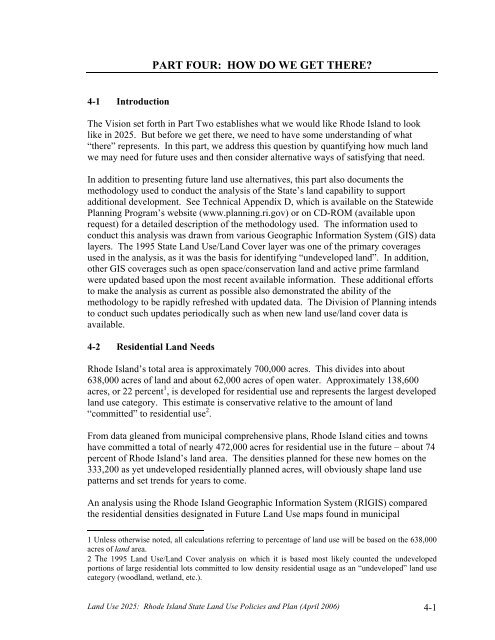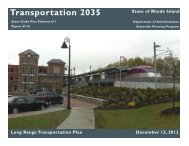Land Use 2025 - RhodeMap RI
Land Use 2025 - RhodeMap RI
Land Use 2025 - RhodeMap RI
- No tags were found...
Create successful ePaper yourself
Turn your PDF publications into a flip-book with our unique Google optimized e-Paper software.
PART FOUR: HOW DO WE GET THERE?4-1 IntroductionThe Vision set forth in Part Two establishes what we would like Rhode Island to looklike in <strong>2025</strong>. But before we get there, we need to have some understanding of what“there” represents. In this part, we address this question by quantifying how much landwe may need for future uses and then consider alternative ways of satisfying that need.In addition to presenting future land use alternatives, this part also documents themethodology used to conduct the analysis of the State’s land capability to supportadditional development. See Technical Appendix D, which is available on the StatewidePlanning Program’s website (www.planning.ri.gov) or on CD-ROM (available uponrequest) for a detailed description of the methodology used. The information used toconduct this analysis was drawn from various Geographic Information System (GIS) datalayers. The 1995 State <strong>Land</strong> <strong>Use</strong>/<strong>Land</strong> Cover layer was one of the primary coveragesused in the analysis, as it was the basis for identifying “undeveloped land”. In addition,other GIS coverages such as open space/conservation land and active prime farmlandwere updated based upon the most recent available information. These additional effortsto make the analysis as current as possible also demonstrated the ability of themethodology to be rapidly refreshed with updated data. The Division of Planning intendsto conduct such updates periodically such as when new land use/land cover data isavailable.4-2 Residential <strong>Land</strong> NeedsRhode Island’s total area is approximately 700,000 acres. This divides into about638,000 acres of land and about 62,000 acres of open water. Approximately 138,600acres, or 22 percent 1 , is developed for residential use and represents the largest developedland use category. This estimate is conservative relative to the amount of land“committed” to residential use 2 .From data gleaned from municipal comprehensive plans, Rhode Island cities and townshave committed a total of nearly 472,000 acres for residential use in the future – about 74percent of Rhode Island’s land area. The densities planned for these new homes on the333,200 as yet undeveloped residentially planned acres, will obviously shape land usepatterns and set trends for years to come.An analysis using the Rhode Island Geographic Information System (<strong>RI</strong>GIS) comparedthe residential densities designated in Future <strong>Land</strong> <strong>Use</strong> maps found in municipal1 Unless otherwise noted, all calculations referring to percentage of land use will be based on the 638,000acres of land area.2 The 1995 <strong>Land</strong> <strong>Use</strong>/<strong>Land</strong> Cover analysis on which it is based most likely counted the undevelopedportions of large residential lots committed to low density residential usage as an “undeveloped” land usecategory (woodland, wetland, etc.).<strong>Land</strong> <strong>Use</strong> <strong>2025</strong>: Rhode Island State <strong>Land</strong> <strong>Use</strong> Policies and Plan (April 2006) 4-1
















